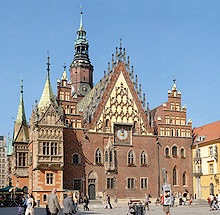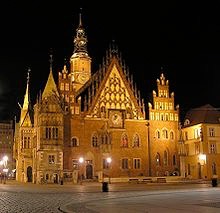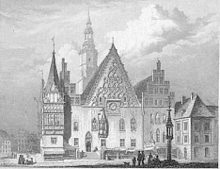Wroclaw, Poland



May 2013
Wroclaw Town Hall
From Wikipedia, the free encyclopedia
Wroclaw Town Hall, east elevation
Wroclaw Town Hall at night
East elevation, around 1860
Clock, east elevation
Wrocław’s Town Hall (the Ratusz/Rathaus) stands at the centre of the City’s Rynek (Market Square). It has a long history reflecting the developments that have taken place in the city over the period since its initial construction.
Today, it continues to be in the service of the city. The Ratusz is used for civic and cultural events (for example, concerts are sometimes held in the Great Hall), it houses a museum, and the basement is now a restaurant.
History
The Ratusz developed over a period of about 250 years from the end of the 13th century though to the middle of the 16th century. The structure and plan changed of course over this extended period in response to the changing needs of the city. History does not record exactly when the initial construction began. However, in the period 1299-1301 the consistorium a single floor structure with cellars and a tower was built. The oldest parts of the current building – the Burghers’ Hall and the lower floors of the tower may date from this time. In these early days, the primary purpose of the building was trade, rather than civic administration.
In 1328-1333, the building was enlarged with the addition of an upper story to house the Council room and the Aldermen’s room. This expansion continued during the 14th century with the addition of extra rooms, most notably the Court room, again indicating an expansion of the role of the building. It was becoming a key location for the city’s commercial and administrative functions.
The 15th and 16th centuries were a time of prosperity for the city of Wrocław, and this is reflected in the rapid development of the Ratusz. The building programme gathered momentum, particularly during the period from 1470 to 1510, when several rooms were added, the Burghers’ Hall was re-vaulted to take on its current shape, and the upper story began to take shape with the development of the Great Hall and the addition of the Treasury and Little Treasury.
Further innovations during the 16th century included the addition of the city’s coat of arms (1536), and the rebuilding of the upper part of the tower (1558-59). This was the final step in the main building programme. By 1560, the major features of today’s Ratusz were established.
The rapid development of the city at this time meant that the Ratusz had to accommodate further administrative functions, and during the 17th century, the allocation of space within the building had to be changed to ensure that all the offices could be housed there. For example, the ground floor was allocated for military purposes, and the general public only had access to the basement, where beer was served.
The second half of the 17th century was a period of decline for the city, and again this was reflected in the Ratusz. Perhaps by way of compensation, efforts were made to enrich the interior decorations of the hall. In 1741, Wrocław became a part of Prussia, and with this change in administration the power of the City diminished, and much of the Ratusz was allocated to the purposes of justice.
During the 19th century there were two major changes. First of all, the administration changed again. The courts moved out to a separate building, and the Ratusz became the focus for the city council and supporting functions. There was also a major programme of renovation as the original building had been neglected and was covered with creepers. The town hall now has a number of neo-Gothic features, including some sculptural decoration from this period.
In the early years of the 20th century improvements continued, with various repair works and the addition of the Little Bear statue in 1902. During the 1930s, the official role of the Ratusz was reduced, and it was converted into a museum. At the end of World War II, about 10% of the building was destroyed. The roofs were seriously damaged, and some sculptural elements were lost.
Restoration work began in the 1950s, following a period of research, and this conservation continued through the 20th century, with a conservation programme, including refurbishment of the clock on the East façade. Today, the Ratusz is open to visitors as the Museum of Bourgeois Art, and is also the venue for cultural events.
Architecture and chambers
The Ratusz sits in the Market square at an angle. It is considered a fine example of Gothic bourgeois architecture. Originally it was a single storey building, and was expanded over the years. The current form dates from the late 15th century with ornaments on the Eastern and Southern facades. The entrance is from the Western side and it leads into the Burghers’ Hall.
The Burghers’ Hall dates from the turn of the 14th century where it housed public gatherings and ceremonies. Later on it was used for commercial purposes. Today it includes a map of Wrocław (a modern copy of a 16th-century map).
The next room is the Aldermans’ Hall, also known as the Court Room. It also dates from 1299. It was used by the members of the municipality. It also has a special podium for the administration of justice. Beyond that lies the Council Chamber, dating from the first half of the 14th century. Here, important city decisions were made and it includes a Renaissance portal from 1528, probably made by Andreas Walter. Until 1945 this room was richly decorated, but some of the elements – wood paneling, furniture and paintings – have been irretrievably lost. The wall paintings and baroque tiled stove, however, have survived.
Next is the Council Office – a place where the council secretary and receiver used to work. This was a popular office for clerks – it was seen as a high-status role. Architecturally, it still includes its padded doors from 1429 and portraits of eminent town councilors.
Upstairs is the Grand Hall. This dates from the second half of the 15th century. Here, official ceremonies took place.














